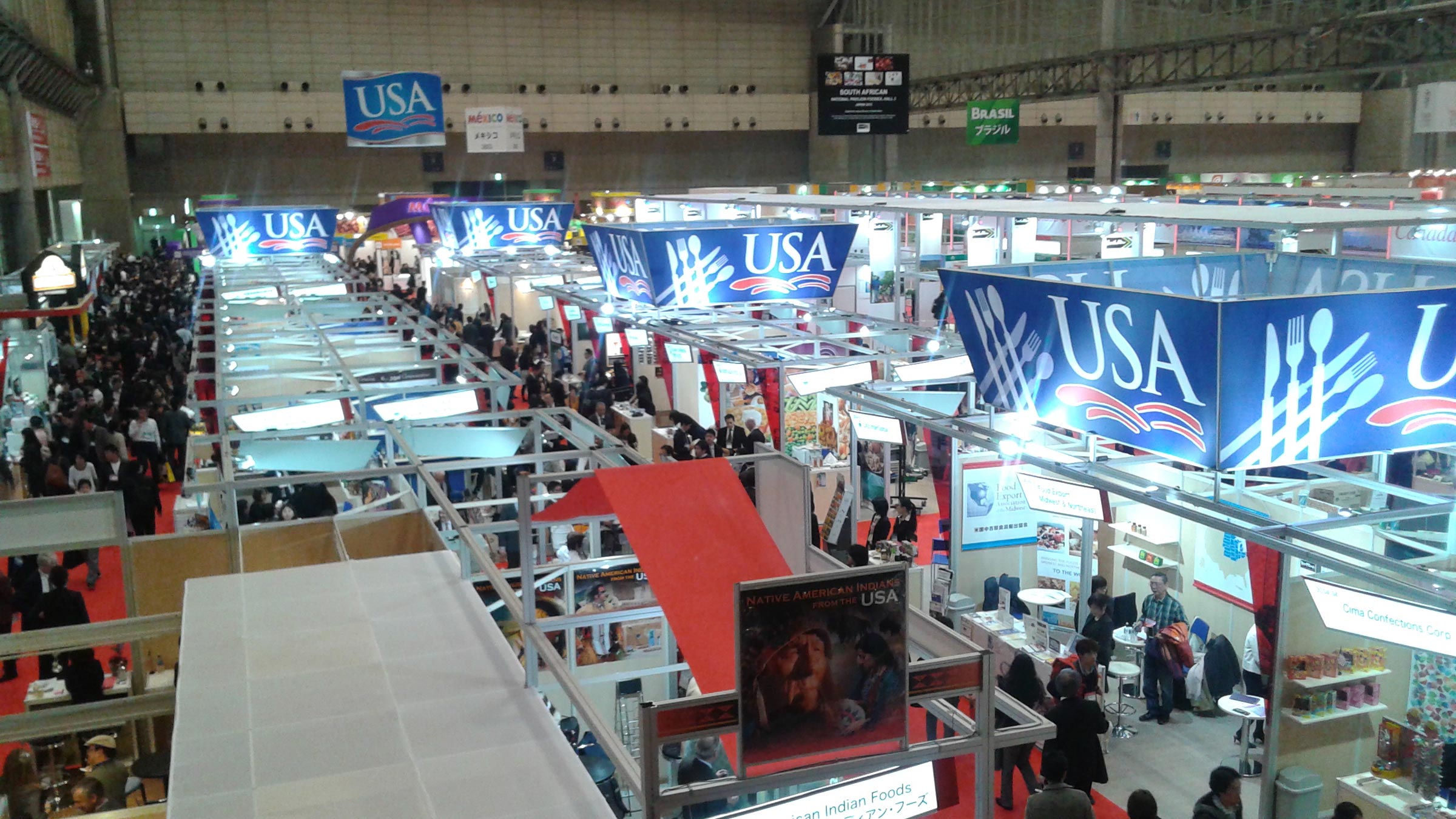
COUNTRY PROFILE
Discover more about the Indonesia market including overviews about the retail, foodservice, and food-processing sectors. Events, resources, and more are linked throughout the profile.

$488.7 million
in processed food exports from the U.S. in 2023

4th
largest market in Southeast Asia for the export of U.S. processed food products

279.3 million
total population in 2023
Euromonitor reports that Indonesia’s economy considerably expanded over 2022, underpinned by the global commodity boom, growing foreign and domestic investments, and increasing private consumption. The economy further increased in 2023, albeit at a slower rate given subdued global demand and tightening monetary policy which is set to undermine business and consumer confidence. Over the medium term, the country is expected to record strong growth, outperforming the average growth rate in Asia Pacific.
Focus Economics reports that the Indonesian economy faces several challenges, including poverty and inequality, poor educational attainment, infrastructure bottlenecks, and corruption, which will likely continue to keep a lid on the country’s economic potential in the coming years. Climate change and extreme weather events are also risks, given that the economy is in a region that experiences tropical storms and tsunamis. The economy should expand notably above the Asia ex Japan average over our forecast horizon to 2028, notwithstanding the aforementioned challenges. Rising tourist arrivals, raw material processing activity, electronics and automobile output will provide support against a backdrop of business-friendly government policy.
Population was 279.3 million in 2023, (CIA World Factbook Est.), an increase of 65 million since 2000. The median age in 2023 was 31.2 years, 6.8 years greater than in 2000. Fertility was nearly halved from 1980 to 2019 and totaled 2.3 births per female at the end of that period. Fertility will gradually fall in the future but will still be about equal to replacement level (2.1 births per female) in 2030. As fertility falls, Indonesia will experience a moderate aging process. The number of those over 65 years totaled 21.4 million in 2023 (7.8% of total population) and the share will rise to 9.2% by 2030.
In November 2020, Indonesia joined the Regional Comprehensive Economic Partnership (RCEP), the world’s largest trade agreement, which consists of 10 Southeast Asian countries, China, Japan, South Korea, Australia, and New Zealand. The pact is anticipated to help progressively reduce tariffs on industrial and agricultural products and contribute to post-COVID-19 pandemic economic recovery across Asia Pacific and Australasia. It will help Indonesia expand its market and integrate further into the global supply chain. Despite the gradual reduction in tariffs and quotas following these agreements, exporters and importers continue to face lengthy and cumbersome custom procedures and non-tariff measures.
USDA’s Jakarta Office of Agricultural Affairs, OAA, hereinafter referred to as FAS Post Jakarta, reports that the country is dominated by productive age (15 to 64 years) consumers, which account for 67.7% of the total population. These consumers are increasingly seeking new products with a focus on health and nutrition. Indonesia’s middle-class is forecast to reach 135 million by 2030, further driving consumer demand while providing a significant opportunity for imported food and beverages.
Despite an often challenging and unpredictable regulatory environment, especially for those products that may compete with local products, opportunities exist for exporters to supply Indonesia’s developed tourism market, growing food processing industry, and modern retail channels.
FAS Post Jakarta reports that import regulations are often complex and non-transparent, thus requiring close business relationships with a local agent. Getting a Food Product Registration (ML) number for imported retail packaged food products is complicated but required. Labels must be written in Indonesian and attached before entering Indonesia. Consumers tend to require smaller package sizes and importers tend to require smaller shipment sizes, making shipments smaller and more costly.
Indonesia is currently the fourth largest market in Southeast Asia for the export of U.S. processed food products. U.S. exports of processed food products increased 17% to US$674 million in 2022. In 2023, processed food exports from the U.S. declined a staggering 27% to US$488.7 million. That is US$186, million which adds to the U.S. deficit in food and agricultural products.
Top U.S. processed food exports to Indonesia in 2023 include:

$41.4 billion
estimated retail sales in the packaged food market in 2023

$100 million
total value of grocery retail sales in Indonesia in 2022

46.8%
projected growth of retail sales in the packaged food market by 2028
According to Euromonitor, retail sales in the packaged food market in Indonesia are estimated to reach US$41.4 billion in 2023, making it by far the largest in Southeast Asia. That represents a growth rate of over nearly 40.2% or US$11.8 billion since 2019. The forecast for growth in this market is also promising. By the year 2028, the retail sales in the packaged food market in Indonesia is expected to reach US$66.7 billion, a growth rate of 46.8%, or US$21.2 billion from 2024.
High growth products in the forecast include:
FAS Post Jakarta reports that due to a large population, growing middle class, and increasing urbanization, Indonesia presents opportunities for a full spectrum of consumer-oriented products. In 2022, the total value of grocery retail sales in Indonesia reached US$100 million, a 9% increase from the previous year due to the easing of pandemic-related measures. Traditional markets still dominate the retail food and beverage sector, accounting for 77% of market share, although they continue to lose market share to modern retail stores and e-commerce. Among modern retail channels, convenience stores make up the largest segment and are expected to continue to grow in number of outlets due to their closer proximity to residential areas and expansion outside of Java Island.
There are now more than 41,000 modern grocery stores in Indonesia. Convenience stores have contributed to the growth in sales of packaged food products in Indonesia as store expansions to rural areas have created opportunities to sell more packaged products. Comparatively, the growth of supermarkets and hypermarkets has been slow, with total stores reaching only 1,842.
There are four players in the hypermarket space (Carrefour/Trans Mart, Giant, Hypermart, and Lotte Mart), and six in the supermarket segment (Alfa Midi, Hero, Superindo, Ranch Market & Farmers Market, Food Mart, The Food Hall). Major convenience stores include Indomaret and Alfamart. Convenience stores have contributed to the growth in sales of packaged food in Indonesia, as store expansions to rural areas have created opportunities to sell more packaged products across the country. Comparatively, the growth of supermarkets and hypermarkets has been slow, with total stores reaching only 1,794.
Indomaret continues to lead the category with more than 19,133 outlets across Indonesia, followed by Alfamart with nearly 16,000 outlets. About 90% of sales value for convenience stores in Indonesia is derived from these two companies, which have modern, integrated distribution systems and centralized procurement. Convenience stores are expected to continue to be the fastest growing grocery retail segment, with an average of 1,000 new outlet expansions each year. Convenience stores have demonstrated their resiliency and necessity during the pandemic, providing reasonably priced products closer to residential areas during periods of mobility restrictions.
Hypermarkets and supermarkets are generally located in malls and shopping centers, and usually offer 5% to 30% imported food and beverage products. The percentage of imported products can be as much as 60% for some premium or high-end stores. Those premium outlets target upper-middle income and high-income consumers with a large variety of imported products such as fresh fruits, meat, snacks, condiments, and dairy. Indonesia mostly imports products that serve as inputs to food manufacturers or are not produced in adequate volumes locally, such as milk powder, French fries, beef, fresh and processed fruits and vegetables, and wine. The U.S. competes with New Zealand, Australia, and the EU in the dairy products category, with China and Australia in the fresh fruit category, and with Australia and India in the beef products category. Consumers in Indonesia view U.S. beef as a high-quality, premium product which competes with Australian beef at high-end supermarkets and hypermarkets, whereas Indian beef (buffalo meat) is mostly sold in traditional wet markets
FAS Post Jakarta advises best prospective U.S. products for the Indonesian food retail market include fresh fruits, beef, cheese, snack foods, frozen food and sauces, dressings, and condiments.

$32 billion
total value of the Indonesian Hotel, Restaurant, Institutional (HRI) industry in 2022

over 30%
increase in value of the HRI industry in Indonesia since 2021

29,742 hotels
offering 788,982 rooms as of 2022
FAS Post Jakarta reports that in 2022, the Indonesian Hotel, Restaurant, Institutional (HRI) industry was valued at US$32 billion, a more than 30% increase from the previous year, making it the largest foodservice market in Southeast Asia. The value of foodservice sales rebounded in 2022 but fell short of reaching pre-pandemic levels. Most of the leading foodservice players are American fast-food chains such as McDonald’s, KFC, Pizza Hut, and Starbucks. U.S. food export prospects in this market include cheese, frozen potatoes, beef, fruits, pork, wine, and tree nut products, mostly used by international hotel chains, high-end restaurants, and international fast-food chains.
KFC, McDonald’s, and Pizza Hut dominate the fast-food chain sector in Indonesia. In 2022, international fast-food chains opened new outlets in primary and secondary cities to expand their network coverage, including McDonald’s, KFC, and Pizza Hut. In 2023, two additional American fast-food chains opened in Indonesia, Popeye’s and Long John Silver’s. The re-opening of Popeye’s chicken in Indonesia was a strategic expansion by Restaurant Brands Asia, catering to growing consumer demand for fried chicken.
In recent years, new restaurants that offer healthy restaurant concepts have sprung up in Jakarta and other prominent cities. KFC’s “Naughty by Nature” outlets in Jakarta offer healthier side options to consume with their fried chicken such as salads. Burger King has added a plant-based Whopper to its menu in Indonesia, made with a vegan beef patty supplied by Unilever. Other restaurant chains that offer healthier menu items include Saladstop! Burgreens and Green Rebel, which has partnered with other stores like Ikea and Starbucks. These restaurants use imported ingredients such as meat, almonds, chickpeas, salmon, seafood, nuts, etc. As Indonesian consumers continue to develop new habits and food preferences, the healthy restaurant concepts with plant-based alternatives will expand in the coming years.
The number of hotels in Indonesia increased significantly from 16,685 to 29,742 hotels, offering 788,982 rooms (2013-2022). Although most international hotel chains are in Jakarta, Bali, Bandung, Surabaya, Yogyakarta, and Medan, more are expanding into secondary cities due to infrastructure development and the promotion of new tourist destinations.
Indonesia’s catering industry is comprised of four categories: hospitality (i.e., hotel, weddings, and other events), institutional, online, and in-flight catering. Hospitality, institutional and online catering services are highly fragmented. Services offered in these categories range from five-star hotels and large institutional suppliers to individually run boutique catering businesses and low-cost providers. In-flight catering, institutional (mining and petroleum companies), and international standard catering services mostly use imported foods such as beef, fresh and canned fruits, frozen potatoes, fruits, cheese, etc. After the COVID-19 pandemic, in-flight and industrial catering services have also started to recover. For example, CAS food, one of Indonesia’s leading catering services, reported that in 2022, the sales value for inflight meals has increased by more than 100% compared to the previous year, and catering for the mining and industrial sectors increased by 35%.
FAS Post Jakarta advises that the HRI industry will continue as a leading consumer of imported food items. Opportunities for high-value U.S. food items include milk and cream powder and cheese, fresh fruits and vegetables, processed fruit, food preparations and ingredients, red meats, (Halal), French fries, bakery dough, butter, fruit and vegetable juices, breakfast cereals and pancake mix and tree nuts.

$40 billion
total retail sales of packaged foods in 2021

9%
increase in exports of U.S. agricultural products to Indonesia in 2022

65%
of Indonesia’s raw materials for its food processing industry are imported
In 2021, retail sales of packaged foods reached $40 billion. Large food processors such as Indofood, Nestlé Indonesia, Frisian Flag Indonesia, and Sarihusada (Danone) lead the way as they produced a variety of products such as snack foods, noodles, dairy products, and beverages. Indonesia currently imports 65% of the raw materials needed for its growing food processing industry. In 2022, exports of U.S. agricultural products to Indonesia increased by 9% largely due to higher demand for soybean, dairy, and beef.
Additionally, the Indonesian Food and Beverage Industry Association (GAPPMI) indicated that its members imported 80% of milk ingredients, 70% of soybeans, 100% of sugar, and 80% of certain salts that they used in their respective manufacturing processes.
FAS Post Jakarta reports that Indonesia currently imports 65% of the raw materials needed for its growing food processing industry. In 2022, exports of U.S. agricultural products to Indonesia increased by 9% largely due to higher demand for soybean, dairy and beef. However, over the past two years, Australia has been overtaking the U.S. to become the largest supplier of imported agricultural products to Indonesia for the first time in seven years, mainly due to a substantial increase in Australian wheat exports to Indonesia in 2021 and 2022, while U.S. wheat market share declined significantly to 1.2% due to supply shortages and uncompetitive prices. Thailand and New Zealand were among the exporting countries that experienced strong export growth to Indonesia in 2022 largely due to a boost in demand for sugar and dairy.
The food and beverage processing industry is comprised of approximately 8,556 large- and medium-sized producers; 1.6 million are considered micro and small-scale producers. Most of the products are consumed domestically (mostly retail) and the market is considered highly competitive.
The Indonesian food processing industry serves a domestic population of 276 million and is increasingly seeking new export markets in the region and globally. According to Statistics Indonesia (BPS), Indonesia’s economy grew 5.3% in 2021, the highest since 2013, marked by the resumption of normal business activities after the COVID-19 pandemic and record-high exports due to the surge in global demand for commodities.
Java Island remained Indonesia’s main economic driver in 2022, accounting for 56% of the country’s economy. The domestic food manufacturing industry is growing, driven by growing middle- and upper-income consumption, which constitutes 82% of national food consumption and growing export markets. Indonesia is Southeast Asia’s largest economy and continues to offer significant market potential for U.S. suppliers of food and ingredients, including consumer-oriented products such as fresh fruits and nuts, as well as products utilized in food processing including soybeans, wheat, milk powder and other dairy products, corn, and beef.
Indonesia has implemented trade agreements with ASEAN countries, the People’s Republic of China, Chile, the Republic of Korea, India, Japan, Hong Kong, New Zealand, Australia, and Pakistan in the form of Comprehensive Economic Partnership Agreements, Free Trade Agreements, and Preferential Trade Agreements. Agricultural products from those countries, such as milk powder, beef, apples, grapes, cheese, and oranges, enter the market at more competitive rates than U.S. products. However, many U.S. products continue to increase their market share based on price, quality, and availability.
The market presents significant opportunities for a range of U.S. agricultural products, including consumer-oriented products: dairy, fresh fruit, beef and beef products, tree nuts, powdered cheese, and dried egg yolk. Intermediate agricultural products: sugar and sweeteners, textured soy protein, cornstarch, natural honey, odoriferous substances.
FAS Post Jakarta advises that primary ingredients such as wheat, refined sugar, soybeans, dairy, fresh fruit, and processed fruit have high demand and are frequently imported. Blending products used for enriching products such as corn starch, potato starch, dehydrated potato, garlic powder, onion powder, and chili powder are also in demand. Coffee extracts or concentrates fresh fruits and vegetables; cheese and tree nuts are also in demand.
